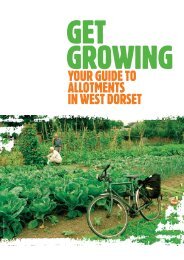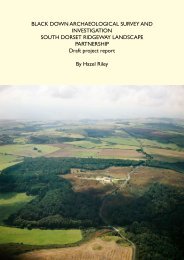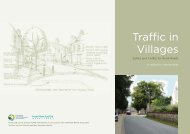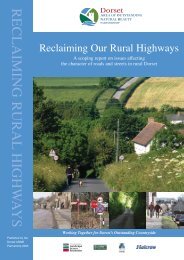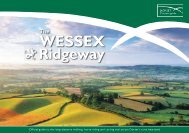Woodland Strategy 11.34 Mb - the Dorset AONB
Woodland Strategy 11.34 Mb - the Dorset AONB
Woodland Strategy 11.34 Mb - the Dorset AONB
You also want an ePaper? Increase the reach of your titles
YUMPU automatically turns print PDFs into web optimized ePapers that Google loves.
Section 7<br />
48<br />
• Identify gaps and means of addressing <strong>the</strong>se relevant to <strong>the</strong> farming and food industry<br />
• Inform priorities in <strong>the</strong> W Implementation Plan of <strong>the</strong> Rural Developemnt Programme for<br />
England 2007-2013<br />
Towards 2015 – South West Tourism<br />
This document details <strong>the</strong> vision for tourism in <strong>the</strong> region combined with <strong>the</strong> key issues and<br />
priorities for action. It should be read in conjunction with <strong>the</strong> annual delivery plans for each<br />
Brand Cluster and Destination Management Organisation.<br />
South West Regional <strong>Woodland</strong> and Forestry Framework<br />
This framework is <strong>the</strong> first point of focus on <strong>the</strong> future of <strong>the</strong> region’s woods and forests. It<br />
sets out priorities for activity across public, private and voluntary sectors and details partners,<br />
actions and resources. Could list <strong>the</strong> main <strong>the</strong>mes of <strong>the</strong> SWRWFF<br />
South West Regional Woodfuel Framework 2005<br />
The framework promotes <strong>the</strong> sustainable management of woodlands through <strong>the</strong> promotion<br />
and use of woodfuel, increasing direct links between communities and local woodlands to<br />
bring environmental, economic and social benefits. This Framework aims to provide a focus<br />
for <strong>the</strong> structure of <strong>the</strong> whole region’s woods and forests and identifies how <strong>the</strong> region can<br />
benefit more from woods and be a better custodian of its existing woods and forests. It sets<br />
out priorities for action for next 10 -100 years. It expands on <strong>the</strong> multifunctional role of<br />
woodland suggesting that it should be viewed as contributing economically, environmentally,<br />
and through tourism.<br />
Local<br />
<strong>Dorset</strong> <strong>AONB</strong> Management Plan<br />
This plan identifies <strong>the</strong> key issues affecting <strong>the</strong> <strong>AONB</strong> and provides a broad policy framework<br />
that has been adopted by <strong>the</strong> local authorities and approved by <strong>the</strong> statutory agencies. This<br />
policy framework will help to ensure <strong>the</strong> conservation and enhancement of <strong>the</strong> <strong>AONB</strong> for<br />
future generations. An Action Plan for 2004-9 has also been produced that sets out <strong>the</strong><br />
specific priority actions that will be undertaken to deliver <strong>the</strong> policies and vision. Within<br />
<strong>the</strong> <strong>Dorset</strong> <strong>AONB</strong> Management Plan trees are seen as a major component of all landscape<br />
types in <strong>Dorset</strong> and a valuable biodiversity resource. The Plan points to woodlands having<br />
an increasing role in landscape improvement, biodiversity, recreation and pollution<br />
amelioration and highlights <strong>the</strong> difficulties decreasing economic value of woodland is<br />
having on <strong>the</strong> management of <strong>the</strong>se areas.<br />
Key issues identified relating to forestry and woodlands are:<br />
• Decline in both quality of native woodland as a result of lack of management,<br />
• Fragmentation of native woodlands<br />
• Introduction of non-native species in plantations<br />
• Decrease in economic and ecological value of woodlands<br />
• Rising deer numbers<br />
• Damage by disease such as Dutch Elm Disease<br />
• The need to a healthy, local market for timber products<br />
• The need to identify new woodland plantings that combine ecological, social, landscape<br />
and recreational benefits.<br />
The report also points out <strong>the</strong> issues of coniferous plantation woodland on heathland and<br />
wetland habitats which are of national importance. The removal of <strong>the</strong>se trees and <strong>the</strong><br />
linking of priority non-wooded habitats through <strong>the</strong> re-creation of open ground of high<br />
nature conservation value is widely accepted, but with a targeted and paced approach.<br />
The woodland, tree and forest strategy will provide <strong>the</strong> backbone for woodland related<br />
issues in <strong>the</strong> <strong>AONB</strong> management plan, which is currently under review.<br />
Landscape Character Assessments<br />
Landscape Character Assessments identify and describe <strong>the</strong> characteristic features of a<br />
landscape through <strong>the</strong> identification of landscape character types and provide guidelines<br />
on how to manage change relevant to each character type. They provide a framework and<br />
information base from which sustainable planning and management can be developed.<br />
With <strong>the</strong> ever increasing emphasis on sustainable development landscape character<br />
assessment is an extremely important tool for making informed decisions, in particular<br />
for identifying new planting, creation of habitat linkages and management of existing<br />
woodlands and forests.<br />
Cranborne Chase <strong>AONB</strong> Management Plan<br />
This plan completed in 2004 identifies 7 key aims ranging from landscape through to<br />
sustainable rural communities. For each aim <strong>the</strong> key issues have been identified and<br />
objective given to progress <strong>the</strong>ir management.<br />
The plan identified <strong>the</strong> following key issues relating to forestry and woodlands:<br />
• Low commercial value of timber leading to lack of management<br />
• The viability of coppice management<br />
• Lack of management leading to a decline in characteristic landscape features<br />
• Ongoing loss of veteran trees coupled with a decline in ancient broad-leaved oak<br />
woodland<br />
• Decline in wet woodland<br />
• A need to restore planted ancient woodland sites<br />
• Inappropriate new planting causing loss of o<strong>the</strong>r important habitats



